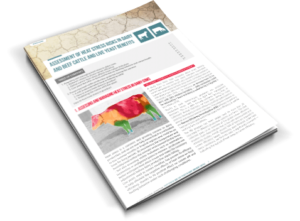Heat stress is a growing concern in dairy and beef production with a strong impact on performance.
Find out how to assess heat stress thanks to the observation of common animal indicators, and discover the power of rumen-specific yeast Saccharomyces cerevisiae CNCM I-1077 (LEVUCELL SC) to help alleviate the negative effects of heat stress in this white paper.
What will you find inside this white paper?
Practical indicators to assess heat stress in dairy and beef operations
Results of Lallemand rumen efficiency survey indicating how heat stress affects main rumen indicators
Results of recent scientific publication with Saccharomyces cerevisiae CNCM I-1077 in dairy cows under heat stress
Practical recommendations to help address summer challenges in dairy and beef
Get your copy now
Heat stress is a common and growing concern in dairy production, and we are now fully aware that it is not limited to two summer months or tropical regions and could be an issue for long periods. By monitoring the temperature and humidity level within the animals’ environment (in the barn) — but also assessing visible indicators such as rumination, locomotion, or undigested grains in manure — producers can better anticipate heat stress issues and make the necessary adjustments before dairy production starts falling.
Although there is less visibility, fattening cattle suffer just as much as dairy cows in warm temperatures. From 25°C onwards, the animal immediately decreases its feed intake, which then takes several days to stabilize again, even at lower temperatures. Rumen conditions and efficiency are challenged by heat stress in beef too, resulting in impaired growth performance and health. Risk monitoring, planning ahead, and adapted barn and herd management practices are essential to optimize production and help overcome heat stress challenges in beef.
Live yeast, used as a rumen modifier, has proven its efficacy to help alleviate the negative effects of heat stress on feed efficiency, thanks to its positive effect on rumen pH and feeding behavior under such challenging conditions in both dairy and beef cattle.
* Not all products are available in all markets nor associated claims allowed in all regions.
Published Apr 27, 2020 | Updated Nov 2, 2023
Related articles
Need specific information?
Talk to an expert
